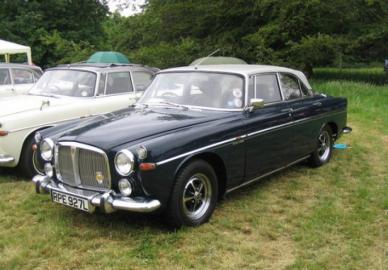Rover P5

The history of the Rover P5
The Rover P5 series (commonly called 3-Litre and 3½ Litre for the engine displacement) was a group of large (in European terms) saloon and coupé automobiles produced from 1958 until 1973. It was a much larger car than the P4 which in some respects it replaced.
Sometimes called a "middle-class Rolls-Royce", the P5 was extremely popular with United Kingdom Prime Ministers and government officials of its day.
The P5 appeared in September 1958, badged as the "3-litre". It was powered by a 2,995 cc (2.995 L; 182.8 cu in) engine. This straight-6 F-head engine used an overhead intake valve and side exhaust valve, an unusual arrangement inherited from the Rover P4. In this form, output of 115 bhp was claimed. An automatic transmission, overdrive on the manual, and power steering were optional with overdrive becoming standard from May 1960.
Stopping power came originally from a Girling brake system that employed 11 inch drums all round, but this was a heavy car and by the time of the London Motor Show in October 1959 Girling front-wheel power discs brakes had appeared on the front wheels.
The suspension was independent at the front using wishbones and torsion bars and at the rear had a live axle with semi-elliptic leaf springs.
A Mark I-A line, introduced in September 1961, featured a minor restyle with added front quarter windows, intended to "assist the dashboard ventilation". Under the metal, the 1A featured modifications to the engine mountings and the automatic transmission.
20,963 had been produced when production of the original Mark I series ended in 1962.
An automatic version tested by The Motor magazine in 1960 had a top speed of 95.0 mph (152.9 km/h) and could accelerate from 0-60 mph (97 km/h) in 17.1 seconds. A fuel consumption of 20.5 miles per imperial gallon (13.8 L/100 km; 17.1 mpg-US) was recorded. The test car cost £1864 including taxes.
The Mark II version of the P5 was introduced in 1962. It featured more power (129 hp/96 kW) from the same 3.0 L engine and an improved suspension, while dropping the glass wind deflectors from the top of the window openings. The most notable addition to the range was the option of the Coupé body style launched in autumn 1962. Unlike most coupés, which tend to be two-door versions of four-door saloons, this retained the four doors and was of the same width and length as the saloon, but featured a roofline lowered by two and a half inches (6 cm) along with thinner b-pillars, giving it the look of a hardtop.
The Mark III was presented at the London Motor Show in October 1965, described at the time as "even more luxuriously trimmed and furnished". It was again available in two 4-door body styles, coupé and saloon. The Mark III used the same engine as its predecessor, but it now produced 134 hp (99 kW). Externally it could be distinguished by the full-length trim strip along the body and Mark III badging; internally it replaced the rear bench seat with two individually-moulded rear seats, making it more comfortable to ride in for four occupants but less so for five.
3,919 saloons and 2,501 coupés were sold when production ended in 1967.
The final iteration of the P5 appeared in September 1967. Now powered by the 3,528 cc (3.528 L; 215.3 cu in) Rover V8 engine also used in the 3500, the car was badged as the "3.5 Litre", and commonly known as the 3½ Litre. The final letter in the "P5B" model name came from Buick, the engine's originator. Rover did not have the budget or time to develop such engines hence they chose to redevelop the lightweight aluminium concept Buick could not make successful. They made it considerably stronger which added some weight but still maintained the engine's light and compact features. The Borg Warner Type-35 automatic transmission, power steering and front Lucas fog lights were now standard.
Output of 160 bhp / 119 kW was claimed along with improved torque. When compared to its predecessor, the aluminium engine enabled the car to offer improved performance and fuel economy resulting both from the greater power and the lesser weight of the power unit.
The exterior was mostly unchanged, apart from bold '3.5 Litre' badging, a pair of fog lights which were added below the head lights, creating a striking 4 light array, and the fitting of chrome Rostyle wheels with black painted inserts. The P5B existed as both the 4-door coupe and saloon body style until end of production. 9,099 coupés and 11,501 saloons had been built when the P5 series ended in 1973.
One of the curiosities of the P5B is that the nearside trim of the front wing is a different length to that of the offside.
Rover for sale
- Rover P5
-
1973 Limburg
 EURO3,500Private sale Views: 6290
EURO3,500Private sale Views: 6290 - Rover P4 90
-
1958 West Yorkshire
 GBP3,750Private sale Views: 10882
GBP3,750Private sale Views: 10882 - Rover P5 MK III
-
1967 Tyne and Wear
 GBP3,650Trade sale Views: 16236
GBP3,650Trade sale Views: 16236 - Rover P5 Mk II
-
1964 Warwickshire
 GBP7,495Private sale Views: 18514
GBP7,495Private sale Views: 18514 - Rover P6
-
1972 Staffordshire
 GBP6,750Private sale Views: 12421
GBP6,750Private sale Views: 12421 - Rover P6
-
1969 London
 GBP4,995Private sale Views: 389
GBP4,995Private sale Views: 389





